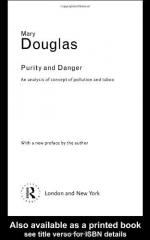
|
| Name: _________________________ | Period: ___________________ |
This test consists of 15 multiple choice questions and 5 short answer questions.
Multiple Choice Questions
1. Which of the following serves as Douglas' distinction between primitive and modern culture?
(a) Cosmic pollution.
(b) Social pollution.
(c) Observing taboo.
(d) Religion.
2. What does the union between God and people involve in Douglas' view?
(a) Pollution.
(b) Perseverance.
(c) Purity.
(d) Struggle.
3. According to Chapter 1, what do contemporary practices divide?
(a) Knowledgeable and ignorant.
(b) Pure and Disgusting.
(c) Safe and unsafe.
(d) Dirty and clean.
4. What do anomalies represent?
(a) Purity.
(b) Differences.
(c) Pollution.
(d) Interpretations.
5. According to Frazer, what did magic lead to?
(a) The best way to live.
(b) Inability to distinguish between associations and reality.
(c) Inability to believe in a religion.
(d) Sacrifice.
6. Which of the following is not involved in categorizing?
(a) Anomaly.
(b) Order.
(c) Patterns.
(d) Authority.
7. In modern societies, how does Douglas believe that wealth distributed?
(a) Role specializations.
(b) Social pollution.
(c) Market considerations.
(d) Unitiy.
8. In which type of world view does Douglas believe the world is seen as subjective and personal?
(a) Polluted.
(b) Primitive.
(c) Modern.
(d) Pure.
9. Which act does Douglas claim led to the recovery of an entire village?
(a) Liver removal.
(b) Appendix removal.
(c) Emotional attachment.
(d) Tooth removal.
10. Douglas believes that if you maintain holiness, what will you be safe from?
(a) Blessings.
(b) Wholeness.
(c) Pollution.
(d) Incompleteness.
11. Which of the following does not interfere with separation in Douglas' beliefs?
(a) Eating an earth animal.
(b) Incest.
(c) Adultery.
(d) Fighting in a polluted state.
12. Which of the following describes Douglas' pre-Copernican classification?
(a) Non-pure.
(b) Non-polluting.
(c) Non-objective.
(d) Non-subjective.
13. In Douglas' view, what does a lack of blessing create?
(a) Separation.
(b) Unity.
(c) Anger.
(d) Confusion.
14. According to Douglas, rituals help to focus through what?
(a) Language.
(b) Emotions.
(c) Religion.
(d) Framing.
15. Whose beliefs did Durkheim adopt when it came to definitions of primitive religion?
(a) Robertson.
(b) Douglas.
(c) Frazer.
(d) Smith.
Short Answer Questions
1. According to Purity and Danger, which of the following can an impersonal universal power not do?
2. Douglas states that all of the following can help to achieve purity except for what?
3. What example of a people is given to demonstration insulation from wrong practices, according to Douglas?
4. Which of the following would not be appropriate for an earth animal, according to the classification?
5. How do people with wills and intelligence respond, according to Douglas?
|
This section contains 376 words (approx. 2 pages at 300 words per page) |

|




